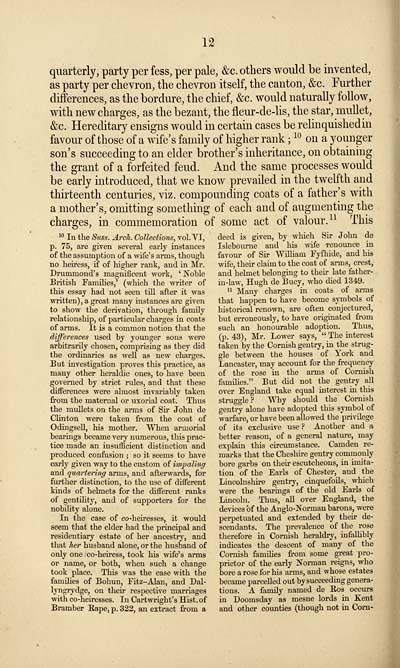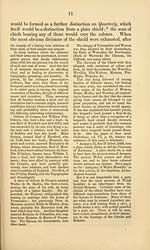Notices of the Ellises of England, Scotland, and Ireland, from the conquest to the present time
(352) Page 348
Download files
Complete book:
Individual page:
Thumbnail gallery: Grid view | List view

12
quarterly, party per fess, per pale, &c. others would be invented,
as party per chevron, the chevron itself, the canton, &c. Further
differences, as the bordure, the chief, &c. would naturally follow,
with new charges, as the bezant, the fleur-de-lis, the star, mullet,
&c. Hereditary ensigns would in certain cases be relinquished in
favour of those of a wife's family of higher rank ; 10 on a younger
son's succeeding to an elder brother's inheritance, on obtaining
the grant of a forfeited feud. And the same processes would
be early introduced, that we know prevailed in the twelfth and
thirteenth centuries, viz. compounding coats of a father's with
a mother's, omitting something of each and of augmenting the
charges, in commemoration of some act of valour. 11 This
deed is given, by which Sir John de
Islebourne and his wife renounce in
favour of Sir WUliain Fyfhide, and his
wife, their claim to the coat of arms, crest,
and helmet belonging to then late father-
in-law, Hugh de Bucy, who died 1349.
11 Many charges in coats of arms
that happen to have become symbols of
historical renown, are often conjectured,
but erroneously, to have originated from
such an honourable adoption. Thus,
(p. 43), Mr. Lower says, "The interest
taken by the Cornish gentry, in the strug-
gle between the houses of York and
Lancaster, may account for the frequency
of the rose in the arms of Cornish
families." But did not the gentry all
over England take equal interest in this
struggle ? Why should the Cornish
gentry alone have adopted this symbol of
warfare, or have been allowed the privilege
of its exclusive use? Another and a
better reason, of a general nature, may
explain this circumstance. Camden re-
marks that the Cheshire gentry commonly
bore garbs on their escutcheons, in imita-
tion of the Earls of Chester, and the
Lincolnshire gentry, cinquefoils, which
were the bearings of the old Earls of
Lincoln. Thus, all over England, the
devices of the Anglo-Norman barons, were
perpetuated and extended by their de-
scendants. The prevalence of the rose
therefore in Cornish heraldry, infallibly
indicates the descent of many of the
Cornish families from some great pro-
prietor of the early Norman reigns, who
bore a rose for his arms, and whose estates
became parcelled out by succeeding genera-
tions. A family named de Eos occurs
in Doomsday as mesne lords in Kent
and other comities (though not in Corn-
10 In the Suss. Arch. Collections, vol. VI,
p. 75, are given several early instances
of the assumption of a wife's arms, though
no heiress, if of higher rank, and in Mr.
Drummond's magnificent work, ' Noble
British Families,' (which the writer of
this essay had not seen till after it was
written) , a great many instances are given
to show the derivation, through family
relationship, of particular charges in coats
of arms. It is a common notion that the
differences used by younger sons were
arbitrarily chosen, comprising as they did
the ordinaries as well as new charges.
But investigation proves this practice, as
many other heraldic ones, to have been
governed by strict rules, and that these
differences were almost invariably taken
from the maternal or uxorial coat. Thus
the mullets on the arms of Sir John de
Chnton were taken from the coat of
Odingsell, his mother. When armorial
bearings became very numerous, this prac-
tice made an insufficient distinction and
produced confusion ; so it seems to have
early given way to the custom of iinpaling
and quartering arms, and afterwards, for
further distinction, to the use of different
kinds of helmets for the different ranks
of gentility, and of supporters for the
nobility alone.
In the case of co-heiresses, it would
seem that the elder had the principal and
residentiary estate of her ancestry, and
that her husband alone, or the husband of
only one co-heiress, took his wife's arms
or name, or both, when such a change
took place. This was the case with the
families of Bohun, Fitz-Alan, and Dal-
lyngrydge, on their respective marriages
with co-heiresses. In Cartwright's Hist, of
Bramber Eape, p. 322, an extract from a
quarterly, party per fess, per pale, &c. others would be invented,
as party per chevron, the chevron itself, the canton, &c. Further
differences, as the bordure, the chief, &c. would naturally follow,
with new charges, as the bezant, the fleur-de-lis, the star, mullet,
&c. Hereditary ensigns would in certain cases be relinquished in
favour of those of a wife's family of higher rank ; 10 on a younger
son's succeeding to an elder brother's inheritance, on obtaining
the grant of a forfeited feud. And the same processes would
be early introduced, that we know prevailed in the twelfth and
thirteenth centuries, viz. compounding coats of a father's with
a mother's, omitting something of each and of augmenting the
charges, in commemoration of some act of valour. 11 This
deed is given, by which Sir John de
Islebourne and his wife renounce in
favour of Sir WUliain Fyfhide, and his
wife, their claim to the coat of arms, crest,
and helmet belonging to then late father-
in-law, Hugh de Bucy, who died 1349.
11 Many charges in coats of arms
that happen to have become symbols of
historical renown, are often conjectured,
but erroneously, to have originated from
such an honourable adoption. Thus,
(p. 43), Mr. Lower says, "The interest
taken by the Cornish gentry, in the strug-
gle between the houses of York and
Lancaster, may account for the frequency
of the rose in the arms of Cornish
families." But did not the gentry all
over England take equal interest in this
struggle ? Why should the Cornish
gentry alone have adopted this symbol of
warfare, or have been allowed the privilege
of its exclusive use? Another and a
better reason, of a general nature, may
explain this circumstance. Camden re-
marks that the Cheshire gentry commonly
bore garbs on their escutcheons, in imita-
tion of the Earls of Chester, and the
Lincolnshire gentry, cinquefoils, which
were the bearings of the old Earls of
Lincoln. Thus, all over England, the
devices of the Anglo-Norman barons, were
perpetuated and extended by their de-
scendants. The prevalence of the rose
therefore in Cornish heraldry, infallibly
indicates the descent of many of the
Cornish families from some great pro-
prietor of the early Norman reigns, who
bore a rose for his arms, and whose estates
became parcelled out by succeeding genera-
tions. A family named de Eos occurs
in Doomsday as mesne lords in Kent
and other comities (though not in Corn-
10 In the Suss. Arch. Collections, vol. VI,
p. 75, are given several early instances
of the assumption of a wife's arms, though
no heiress, if of higher rank, and in Mr.
Drummond's magnificent work, ' Noble
British Families,' (which the writer of
this essay had not seen till after it was
written) , a great many instances are given
to show the derivation, through family
relationship, of particular charges in coats
of arms. It is a common notion that the
differences used by younger sons were
arbitrarily chosen, comprising as they did
the ordinaries as well as new charges.
But investigation proves this practice, as
many other heraldic ones, to have been
governed by strict rules, and that these
differences were almost invariably taken
from the maternal or uxorial coat. Thus
the mullets on the arms of Sir John de
Chnton were taken from the coat of
Odingsell, his mother. When armorial
bearings became very numerous, this prac-
tice made an insufficient distinction and
produced confusion ; so it seems to have
early given way to the custom of iinpaling
and quartering arms, and afterwards, for
further distinction, to the use of different
kinds of helmets for the different ranks
of gentility, and of supporters for the
nobility alone.
In the case of co-heiresses, it would
seem that the elder had the principal and
residentiary estate of her ancestry, and
that her husband alone, or the husband of
only one co-heiress, took his wife's arms
or name, or both, when such a change
took place. This was the case with the
families of Bohun, Fitz-Alan, and Dal-
lyngrydge, on their respective marriages
with co-heiresses. In Cartwright's Hist, of
Bramber Eape, p. 322, an extract from a
Set display mode to:
![]() Universal Viewer |
Universal Viewer | ![]() Mirador |
Large image | Transcription
Mirador |
Large image | Transcription
Images and transcriptions on this page, including medium image downloads, may be used under the Creative Commons Attribution 4.0 International Licence unless otherwise stated. ![]()
| Histories of Scottish families > Notices of the Ellises of England, Scotland, and Ireland, from the conquest to the present time > (352) Page 348 |
|---|
| Permanent URL | https://digital.nls.uk/95549837 |
|---|
| Description | A selection of almost 400 printed items relating to the history of Scottish families, mostly dating from the 19th and early 20th centuries. Includes memoirs, genealogies and clan histories, with a few produced by emigrant families. The earliest family history goes back to AD 916. |
|---|

